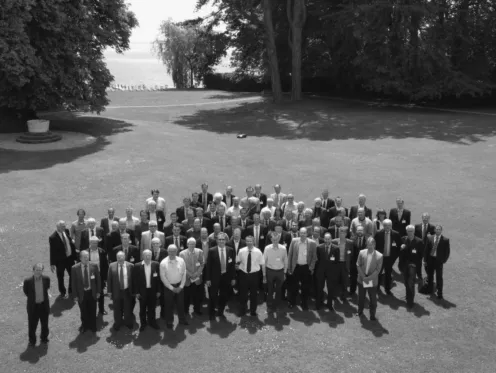![]()
Chapter 1
Computational Fluid Dynamics: The Future in Safety Technology!
Jürgen Schmidt
Safety engineering is based on reliable and conservative calculations. With Computational Fluid Dynamics (CFD) tools, the knowledge of certain physical processes is deepened significantly. However, such programs are currently not standard. In safety engineering more stringent demands for accuracy must be set, for example, as compared to methods for the optimization of plants. The methods must, among other things, be sufficiently validated by experiences or experimental data and fully documented (method transparency). In addition, they must be comprehensible, reproducible, and economical to apply. The necessary demands on precision can usually only be met by model developers, program suppliers, and users of the CFD codes (common sense application).
The developers of models must document their models, and the assumptions under which the models were derived must be fully understandable. Only if the application range is carefully described can a responsible transfer to other fluids and parameter rages take place at some later time. Unlike simple empirical correlations, CFD models, with their many sub-models, often appear complex and not transparent. The validation is usually done only on certain individual data points or by measuring global parameters such as pressures and mass flows. This makes it difficult to assess whether a method is more generally applicable in practice. Margins of error cannot be estimated, or only very roughly. There are relatively for model validations for typical questions in the field of safety engineering. However, even there only models and methods with sufficiently well-known uncertainties should be applied.
It is still not enough if only the model application ranges are transparent. In addition it should be possible to review the CFD program codes. Most codes are not currently open source. Moreover, frequent version changes and changes in the program codes complicate any review. Generally accepted example calculations which can be used for revalidation (safety-relevant test cases) are usually lacking. There are often demands for open-source programs among the safety experts. This certainly facilitates the testing of models. On the other hand, in practice it is then only barely comprehensible what changes were made in a program in any particular case.
CFD calculations are reasonably possible in safety technology only with a good education and disciplined documentation of the results.
A university education should provide any students with:
- A fundamental knowledge of numerical modeling, including an understanding of the mathematical solution procedures, their use and application boundaries, and the influence of initial and boundary conditions.
- Experience in the application of safety-related models and methods.
- Analytical skills to be able to evaluate safety-related calculation results for abnormal operation conditions on the basis of experimental studies performed with other fluids and under normal conditions.
- A training in how to assess the self-evident plausibility of calculation results with the help of shortcut methods.
- A technical safety mindset and approach in dealing with computational methods and the evaluation of results.
These requirements are currently being taught in their entirety in hardly any of the major universities. Students often lack the mathematical skills of numerical modeling, a deeper understanding of turbulence models, or simply the experimental experience to assess calculation results. At some institutions, CFD codes are used as black boxes. Student training needs to be adjusted. A major effort to teach these necessary skills is essential.
Particularly in safety engineering, CFD programs are currently (still) used by a relatively small circle of experts. Careful documentation of results in this area is particularly important. In addition to input and output data, the initial and boundary values as well as the chosen solution method and model combinations must be recorded. These data are often very extensive. It may therefore be useful to keep all programs and necessary files long-term on appropriate computers. Again, it would be helpful if certain practices were well established and documented as standard – this is lacking in safety engineering.
In addition to the required computational results, sensitivity analysis of individual parameters is desirable. With CFD programs a deeper understanding of the physical processes can arise from that analysis. Alternatively it may turn out that the chosen combination of models is not suitable to solve a specific problem. Even with sensitivity analysis, the user has the duty to responsibly perform and document them as an additional part of the actual calculations.
For a third party, the CFD calculation results can in principle only be evaluated and understood from a safety point of view with much more effort. Even the inspection authorities must have sufficient expertise. For the industrial application of CFD programs in the field of safety technology, the exchange between learners and experts, and training specifically with experts from both safety engineering and CFD, are necessary. At the symposium in Tutzing, a “CFD's license” was proposed. The ensuing discussion revealed the following applications for CFD calculations in safety engineering:
1. To gain additional in-depth knowledge and understanding of physical processes. This is especially true if the effect of individual parameters to be investigated or detailed information about the spatial and temporal distribution of individual parameters is required.
2. To visualize process operational work flows.
3. To use as the sole source of information in areas where no experiments are possible (hazardous materials, very high pressures).
4. To examine boundary conditions as specified for conventional models.
5. To interpolate experimental results.
6. To question conventional methods and standards. This includes the improvement of these methods and the reduction of safety margins due to higher accuracy of the models.
CFD programs are already used in the field of safety technology for the optimization of valve operations, the investigation of fires and explosions, the examination of single-phase fluid flows, the propagation of liquid pools from leaks, and generally for the investigation of incidents. In contrast, there are also some areas where the CFD computer codes should not be used, namely:
- when simple models are adequate,
- if they are the only source of information to design safety devices,
- for unknown or fluctuating initial and boundary conditions,
- for extrapolations beyond a range with experimentally validated data,
- if only insufficient property data are available, or
- to solve very complex problems with many parameters.
Typically, established and conventional methods are applied to design safety measures and to size safety devices. With increasing risk, these standards are more important. For most of the safety experts it is currently not viable to size safety devices solely on the basis of CFD simulations. It is however expected that this will change in the future.
According to the information of the participants, 48% of the participants of the Tutzing symposium in 2011 with a safety-related background and 68% of the numerically trained participants trust in CFD simulations applied for safety engineering tasks. Training and experience, experimental validation of models, and the definition of standards (Best Practice) are the relevant criteria in order to further increase confidence.
In summary, the discussion in the Tutzing symposium has shown that CFD computer codes are used in safety technology with different intensity according to specific tasks. CFD has arrived in safety technology! The advantages of these tools show up in all areas of technology. But the dangers in the application of safety technology have also been impressively demonstrated, for example:
1. The extrapolation of validated results from highly non-linear CFD models can lead to extreme errors.
2. In safety technology, initial and boundary value problems often cannot be defined with the necessary accuracy. This may result in large errors or large uncertainties in the results of a CFD simulation. In many cases these uncertainties cannot be quantified.
3. The most often used eddy viscosity turbulence models dampen smaller fluctuations and in principle do not allow for the adequate resolution of a problem in some cases. In contrast, Large Eddy Simulation (LES) or Direct Numerical Simulation (DNS) are typically more precise but increase the computation time enormously.
Only with sufficient training and experience in dealing with the CFD models and their solution methods can questions in the field of safety technology be answered responsibly. Any ‘black box’ CFD application mentality in which results are firstly obtained by systematic variation of models and adaptation of internal model parameters to very few experimental data and secondly presented as validated results and subsequently used for extrapolations must be strictly avoided. Of course, this applies to any type of modeling in safety technology. An extended study program at German and international universities is needed to inculcate the necessary safety skills and mindset in the next generation of students. At the same time, interdisciplinary numerical, experimental, and safety skills must be taught – just a new kind of computational Safety Engineering. For practical application in industry the idea of a CFD license or quality labels should be pursued.
The CFD computer codes should be supplemented as a standard tool by best practice guidelines in the field of safety technology and by many test cases from the professional safety community. The research and development work on the way to such standard tools (and common sense) can only enhance the training of safety engineers in the field of CFD, the acceptability of the methods, and ultimately the current state of safety technology.
With CFD tools, the demand for necessary safety measures and economic operation of plants can be merged. The knowledge so gained is considerable, and the trend toward making increasing use of these tools is already equally considerable. As long as the results are physically based on a meaningful theory and are responsibly weighted by safety considerations, this is the right way into the future of safety technology.
The 50th Tutzing Symposium 2011, organized by the community of safety technology of the Dechemás ProcessNet initiative, has brought experts from the fields of safety engineering and numerical modeling together for a first major exchange of views. Only when these two disciplines grow closer together will CFD be able to establish itself as a standard tool in all areas of safety technology.
![]()
Chapter 2
Organized by ProcessNet: Tutzing Symposion 2011 ‘CFD – its Future in Safety Technology’
Norbert Pfeil
This contribution to the present book is intended to act as a bridge between the continuous work of ProcessNet's Safety Engineering Section and the 50th Tutzing Symposion entitled ‘CFD – its Future in Safety Technology?’ held in May 2010 at the Evangelische Akademie Tutzing at Lake Starnberg, Bavaria. It may also hopefully make both ProcessNet and its Safety Engineering Section better known, particularly in the international process and plant safety community.
2.1 ProcessNet – an Initiative of DECHEMA and VDI-GVC
In December 2006 DECHEMA (the German society for chemical engineering and biotechnology) and VDI-GVC (the German society of engineers and society for chemical and process engineering) united all their chemical and process engineering activities under a common umbrella: ProcessNet. Nearly a hundred committees of both societies with a wide variety of scientific and technical tasks of various kinds organized their work within the eight ProcessNet sections
Chemical Reaction Technology
Fluid Dynamics and Separation
Particle Technology and Product Design
Process, Apparatus, and Plant Technology
Safety Engineering
SuPER (Sustainable Production, Energy and Resources)
Materials, Construction, Lifetime
Education and Innovation.
Since then, ProcessNet has acted successfully as the one German platform on chemical engineering with more than 5000 memb...


